Archive:EU citizens living in another Member State - statistical overview
This article has been archived.
Highlights
Among the EU citizens of working age, 3.3 % resided in an EU country other than that of their citizenship in 2020.
In 2020, EU citizens living in another EU country had a higher employment rate (73.1 %) than those residing in the country of which they were citizens (72.4 %).
EU mobile citizens of working age (20-64) by country of citizenship, % of their home-country resident population, 2010 and 2020
The free movement of workers is a fundamental right guaranteed by the Treaty on the Functioning of the European Union (EU). Therefore, EU citizens are entitled to: look for a job in another EU country; work there without needing a work permit; reside there for that purpose; stay there even after employment has finished; and enjoy equal treatment with nationals in access to employment, working conditions and all other social and tax advantages. But how many EU citizens take advantage of this right, and reside and work in another EU Member State? Which are the main countries, both in absolute and relative terms? What are the characteristics of these “mobile” citizens, especially in terms of level of education and employment rate, if compared with the “non-mobile” EU citizens (those residing in their country of citizenship)? These are the main questions which this article tries to answer, based on Eurostat’s datasets on labour mobility.
Full article
Key messages
Among the EU citizens of working age (20-64), 3.3 % resided in an EU Member State other than that of their citizenship in 2020. This share has slightly increased over time, as in 2010 it stood at 2.4 %. In 2020, the share of EU mobile citizens out of the resident population of their country of citizenship also varies very much between countries, ranging from 0.8 % in Germany to 18.6 % for Romania. People with tertiary level education were generally slightly less mobile than the rest of the population, and this was especially the case for Portugal, Greece, Croatia and Romania. On the other hand, the mobile citizens of France, Germany and Finland were much more likely to have a tertiary degree than the general population in those countries. The employment rate of mobile EU citizens stood at 73.1 % in 2020, compared to an EU average of 72.4 % overall. It ranged from 85.2 % for Slovenians to 61.8 % for Bulgarians. In most countries the figures were higher than the employment rates found in the corresponding country of citizenship and also than the EU average. Between 2010 and 2020 there has been a smaller increase in the employment rate of mobile EU citizens (4.0 percentage points - pp) compared to the total population (4.6 pp).
Who are the most mobile EU citizens?
Romanians and Croatians leave their country of origin in the highest proportions, while the contrary is true for German, Swedish and French citizens.
In 2020, Romanian citizens of working age (20-64) residing abroad within the EU accounted for about a fifth (18.6 %) of the population residing in Romania, making them the largest national group among EU mobile citizens. The next three national groups accounted for between 10.3 % to 17.6 % of the resident populations of their countries of citizenship: Bulgarians (10.3 %), Portuguese (10.6%), and Croatians (17.6%). The EU Member States with the smallest share of mobile citizens (out of the resident population of country of citizenship) were Germany and Sweden (both under 1.0 %). In another nine Member States this share was 3 % or less. Overall, EU mobile citizens accounted in 2020 for 3.3% of total EU resident population, which was 0.9 pp more than in 2010. On the other hand, when looking at absolute numbers, in 2020 the most numerous national groups of mobile EU citizens aged 20-64 were those from Romania (2 300 100 persons), Italy (1 027 800 persons), Poland (1 005 500 persons) and Portugal (679 600 persons) .
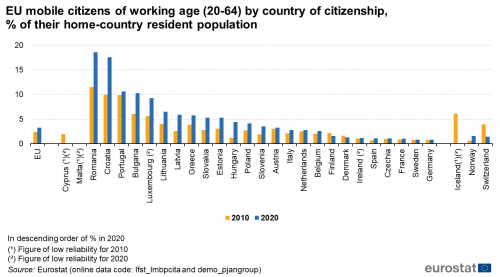
Source: Eurostat (lfst_lmbpcita) and (demo_pjangroup)
Over the last decade, when looking at the percentage increase of EU mobile citizens as a share of the resident population of their country of citizenship, Romanians remained at the forefront. The proportion of Croatian mobile citizens increased by 7.6 percentage points (pp) followed by Romanians (7.1 pp). Opposite to this, the corresponding share of mobile Finnish citizens in total resident population of Finland decreased from 2.2 % in 2010 to 1.5 % in 2020, which is the biggest percentage decrease among EU mobile citizens. The share of resident population of corresponding country of citizenship for another 13 national groups (12 Member States and one EFTA country) remained stable over the decade, with percentage differences ranging from -1 pp to +1 pp. For these countries, the share of mobile citizens in 2020 was also on the low side, ranging from 0.8 % in Germany to 2.8 % for Italy (with the exception of Portugal, where it stood at 10.6 %). However, 3 out of these 13 countries (Italy, Spain and France) whose share of mobile citizens in total resident population of corresponding country of citizenship remained almost unchanged, experienced an increase of over 50 000 citizens in absolute numbers. In particular, the number of Italian citizens residing elsewhere in the EU grew by 235 000, Spanish by 123 000 and French by 58 800 citizens.
Tertiary graduates among the EU mobile citizens
Tertiary graduates were overall slightly less mobile than the rest of the population
In 2020, the proportion of tertiary graduates ranged from 66.4 % of the French to 15.2 % of Romanian mobile citizens. Figure 2 indicates that those living abroad in another EU country were slightly less likely to have attained tertiary level education than those residing in the country of which they are citizens. However, at the national level this was only the case in Romania, Croatia, Bulgaria, Greece and Portugal. For the other Member States, their citizens with tertiary education were more mobile than the rest of the population. For seven countries the difference was quite notable, ranging from 12.2 pp in the case of Italian citizens to almost 27.4 pp for French citizens (in favour of mobile citizens). There were also very large differences to be observed in the proportion of tertiary graduates within national resident populations, which ranged from 46.3 % in Ireland to 17.6 % in Romania. This should be correlated with the corresponding variations among EU mobile citizens. One interesting conclusion is that tertiary graduates were generally more mobile than the rest of the population in the countries that were part of the European Union before the 2004 accession (with the notable exceptions of Greece and Portugal).
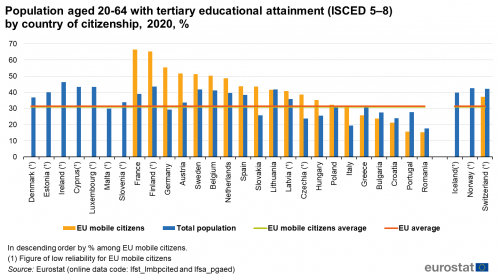
Source: Eurostat (lfst_lmbpcited) and (lfsa_pgaed)
The share of the highly skilled amongst mobile EU citizens grew by 7.3 pp between 2010 and 2020, at a slightly lower rate than for the total population in the EU (7.9 pp)
The share of highly skilled persons amongst mobile EU citizens grew from 23.7 % in 2010 to 30.9 % in 2020, close to the rate for the total population in the EU (which grew from 23.4 % to 31.3 %). The increase amongst the mobile EU citizens ranged from more than 25 pp in Finland to just 2.2 pp in Bulgaria. Only two nationalities registered a decrease, Hungarian (0.2 pp) and Belgian (0.1 pp), while there has been an increase of 6.8 pp and 7.4 pp respectively for their resident population. In nine of the EU Member States out of the 20 EU Member States for which data are available, the proportion of the highly skilled amongst their mobile citizens increased more rapidly than amongst the resident population of their corresponding country of citizenship. The reverse is true for Belgium, Bulgaria, Czechia, Lithuania, Hungary, the Netherlands, Austria, Poland, Portugal, Romania and Sweden.

Source: Eurostat (lfst_lmbpcited) and (lfsa_pgaed)
What are the employment rates of mobile EU citizens?
Higher employment rates among mobile EU citizens than among the resident population of their country of citizenship
The employment rate of mobile EU citizens stood at 73.1 % in 2020, compared to an EU average of 72.4 % overall. It ranged from 85.2 % for the mobile Slovenians to 61.8 % for mobile Bulgarians. Figure 3 indicates that in most countries the employment rates of mobile EU citizens were higher than those of the resident population of their corresponding country of citizenship. The differences were significant in the cases of Greek, Croatian and Spanish citizens living abroad in the EU. In these cases, the difference was larger than 10 pp, reaching 15.5 pp for Greek citizens. A significant difference in employment rates between the country of origin and the countries of destination (the European labour market) was probably an important pull factor. On the other hand, in eight Member States (Bulgaria, Czechia, Romania, Estonia, the Netherlands, Germany, Latvia and Sweden) employment rates are higher in the countries of citizenship than for the mobile citizens (by between 11.6 pp for the former to 0.3 pp). This is most likely because migration from these countries is also motivated by other reasons than seeking employment (for example family reunification, the pursuit of higher education or early retirement).

Source: Eurostat (lfst_lmbercita) and (lfsa_ergan)
Employment rates for mobile EU citizens increased faster over the last decade than for the total population
The employment rate of mobile EU citizens increased from 69.1 % in 2010 to 73.1 % in 2020 (+4.0 pp). For all EU nationalities, the same trend was observed (see Table 2). The increase in employment rates of mobile citizens was larger than 10 pp in the case of Swedish, Finnish, Czech, Lithuanian and Slovenian citizens. For another 12 nationalities the increase was between 5 pp and 10 pp. In order to contextualise this information it can be specified that, over the same period, the EU average increase in employment rates was 4.6 pp. Only in one Member State (Greece) was there a decrease of 2.7 pp.

Source: Eurostat (lfst_lmbercita) and (lfsa_ergan)
Employment rates of female mobile EU citizens
Employment rates for mobile women higher than the EU average for females
The employment rate of female mobile EU citizens in 2020 ranged from 83.3 % for Finnish women to 52.2 % for Bulgarian women, while the female EU average stood at 66.5 %. In most cases, the employment rate of mobile EU women was higher than both the female EU average employment rate and that of women residing in the corresponding countries of citizenship. The number of exceptions was, however, higher than for the total rates (see Figure 4). For Dutch and Bulgarian female citizens, the employment rate of those residing abroad is more than 8 pp less than that found in their corresponding country of citizenship. The same trend can be noted amongst the Swiss females. As noted earlier, this could be partially explained by the fact that EU citizens can have also different motivations to live abroad, for example family reasons, more likely found amongst women (see First and second-generation immigrants - statistics on main characteristics). On the other hand, female employment rates are higher for the mobile citizens in the case of eleven EU nationalities. The differences range from as little as 1.2 pp for Portugese women to more than 20 pp for those of Greek nationality, reaching a maximum of 22.6 pp. With very few exceptions (Belgium, Romania and Bulgaria), the employment rates for women residing in another EU country were higher than the EU average for females, which stood at 66.7 % (0.2 pp higher than for mobile females).
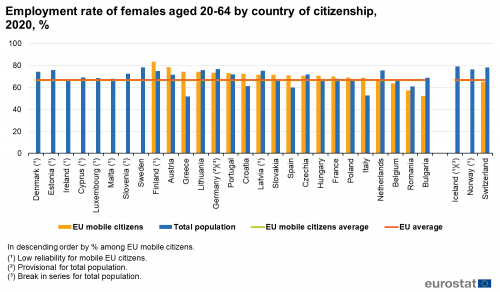
Source: Eurostat (lfst_lmbpcita) and (lfsa_ergan)
Employment rates of highly skilled mobile EU citizens
Highly skilled mobile EU citizens had overall a slightly lower employment rate compared with those with same level of skills residing in their country of citizenship
Employment rates were always higher for the highly skilled EU citizens than for the rest of the population, with the average EU figure standing at 83.9 % in 2020 compared with 72.4 % for the total population. For mobile citizens it ranges from 89.9 % for Swedes to 69.7 % for Bulgarians, while the EU average is 81.7 %. Therefore, the figure is slightly lower (2.2 pp) than for the total population with an equivalent educational level. Also at national level, the employment rate of the highly skilled mobile EU and EFTA citizens is not, in most cases, higher than that of the resident population of their corresponding country of citizenship with the same level of education. In fact it is lower by more than 5.0 pp in Denmark, the Netherlands, Poland, Latvia, Lithuania, Romania and Bulgaria. Most countries in which the reverse was true in 2020 (mobile highly skilled citizens have higher employment rates, more than 4 pp. than those who are not mobile) are situated in the Mediterranean area (Greece, Italy and Spain). It seems that in these countries tertiary graduates find it difficult to find jobs in their country of nationality and easier abroad.
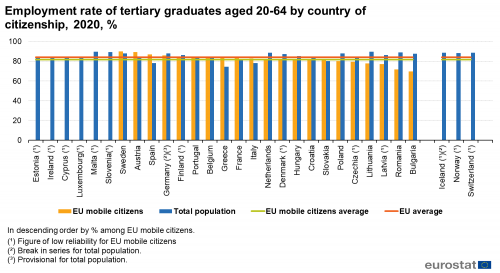
Source: Eurostat (lfst_lmbercited) and (lfsa_ergaedn)
Employment rates of low skilled mobile EU citizens
Mobile low skilled EU citizens had systematically higher employment rates than their co-national peers.
By comparison, the employment rates of citizens with solely primary education are overall low: the EU average stood at 54.9 % in 2020. On the other hand, for mobile citizens the average stood at 64.8 % (9.9 pp higher), ranging from 81.6 % for Hungarian low skilled mobile citizens to 53.3 % for Bulgarians. Also at national level, the employment rates of mobile low skilled EU citizens were almost systematically higher in 2020 than for the resident population in their corresponding country of citizenship. The differences are higher than 10 pp for Italians, Greeks, Poles, Hungarians and Croatians, reaching 33.1 pp for the later.
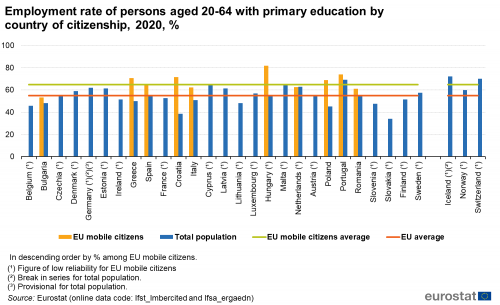
Source: Eurostat (lfst_lmbercited) and (lfsa_ergaedn)
Source data for tables and graphs
Data sources
The section Labour mobility provides demographical and labour statistics on people of working age (15-64) either born in the European Union (EU) and European Free Trade Association (EFTA) area or having the citizenship of an EU/EFTA country and residing elsewhere on the EU and EFTA territories except their country of birth/citizenship. This implies a new “emigration” (country of origin) perspective, as the estimates coming from the Labour Force Survey (EU-LFS) of all EU/EFTA countries, except that of origin or nationality, are aggregated in order to find all the persons of a certain nationality or country of origin that reside elsewhere where the EU rules regarding the free movement of people apply. On the other hand, they can be effectively identified only if a change of residence implying crossing a border has taken place, meaning they reside (or intend to do so) in another country for at least 12 months. Short-term movements are therefore not taken into account. It must also be noted that the citizens residing in the country of their citizenship may have also simply acquired the citizenship of their country of residence (while being born elsewhere in the EU), or might have come back to their country of origin after having resided in another one. This type of information is not captured in the data used; these persons cannot be identified as mobile EU citizens for the purpose of the present article. Conversely, it is possible that some of the “mobile citizens” identified according to this definition are in fact second-generation migrants born in the country in which they reside and that have not, for various reasons, acquired the citizenship of that country and instead have the one of their parents. These limitations come from the fact that the present article focuses on the country of citizenship and not the country of birth perspective. The data sets in the labour mobility section include both separately. Briefly, the reference area is the European Union territory while the population coverage includes the current 27 EU Member States plus the EFTA countries (except for Lichtenstein which does not participate in the EU LFS data collection). The analysis is restricted to the working age population 20-64, in order to limit as much as possible the impact of those who are not (yet/ any longer) active on the labour market and are more likely to be abroad for studying (or retirement) rather than employment reasons.
Context
The free movement of workers is a fundamental principle of the Treaty enshrined in Article 45 of the Treaty on the Functioning of the European Union and developed by EU secondary legislation and the Case law of the Court of Justice. EU citizens are entitled to: look for a job in another EU country; work there without needing a work permit; reside there for that purpose; stay there even after employment has finished and enjoy equal treatment with nationals in access to employment, working conditions and all other social and tax advantages. EU nationals may also have certain types of health and social security coverage transferred to the country in which they go to seek work (see coordination of social security systems).
Free movement of workers also applies, in general terms, to Iceland, Liechtenstein and Norway, which are part of the European Economic Area. People working in some occupations may also be able to have their professional qualifications recognised abroad (see mutual recognition of professional qualifications).
EU social security coordination provides rules to protect the rights of people moving within the EU, Iceland, Liechtenstein, Norway and Switzerland.
The EU is working to increase fair labour mobility in Europe by removing barriers that hinder it. The EU supports mobility by helping job-seekers and employers in Europe find each other, wherever they are. It also seeks to make sure that the EU's mobile workers are not abused (for example through the Posting of workers directive, May 2014 (Official Journal of the EU) and to help coordinate the fight against undeclared work (Decision on establishing a European Platform to enhance cooperation in tackling undeclared work (Official Journal of the EU).
Direct access to
- Labour mobility (lfst_lmb)
- EU/EFTA citizens of working age who usually reside in another EU/EFTA country by citizenship and age (lfst_lmbpcita)
- EU/EFTA citizens of working age who usually reside in another EU/EFTA country by citizenship, age and sex (lfst_lmbpcitg)
- EU/EFTA citizens of working age who usually reside in another EU/EFTA country by citizenship age and educational attainment level (lfst_lmbpcited)
- Employment rate of EU/EFTA citizens who usually reside in another EU/EFTA country by citizenship and age (lfst_lmbercita)
- Employment rate of EU/EFTA citizens who usually reside in another EU/EFTA country by citizenship, age and sex (lfst_lmbercitg)
- Employment rate of EU/EFTA citizens who usually reside in another EU/EFTA country by citizenship, age and educational attainment (lfst_lmbercited)
- The Treaty on European Union
- The Treaty on the Functioning of the European Union
- Directive 2004/38/EC
- Summaries of EU Legislation: EU freedom of movement and residence
- Regulation (EU) No 492/2011
- Regulation (EC) No 883/2004
- Summaries of EU Legislation: Coordination of social security systems
- Regulation (EC) No 987/2009
- Summaries of EU Legislation: Social security system — Cooperation between EU countries
Several Communications from the Commission:
- COM (2002) 694 final Free movement of workers – achieving the full benefits and potential
- Summaries of EU Legislation: Achieving the full benefits and potential of free movement of workers
- COM (2010) 373 final Reaffirming the free movement of workers: rights and major developments
- Summaries of EU Legislation: Free movement of workers: taking stock of their rights
- COM (2013) 837 final Free movement of EU citizens and their families: Five actions to make a difference